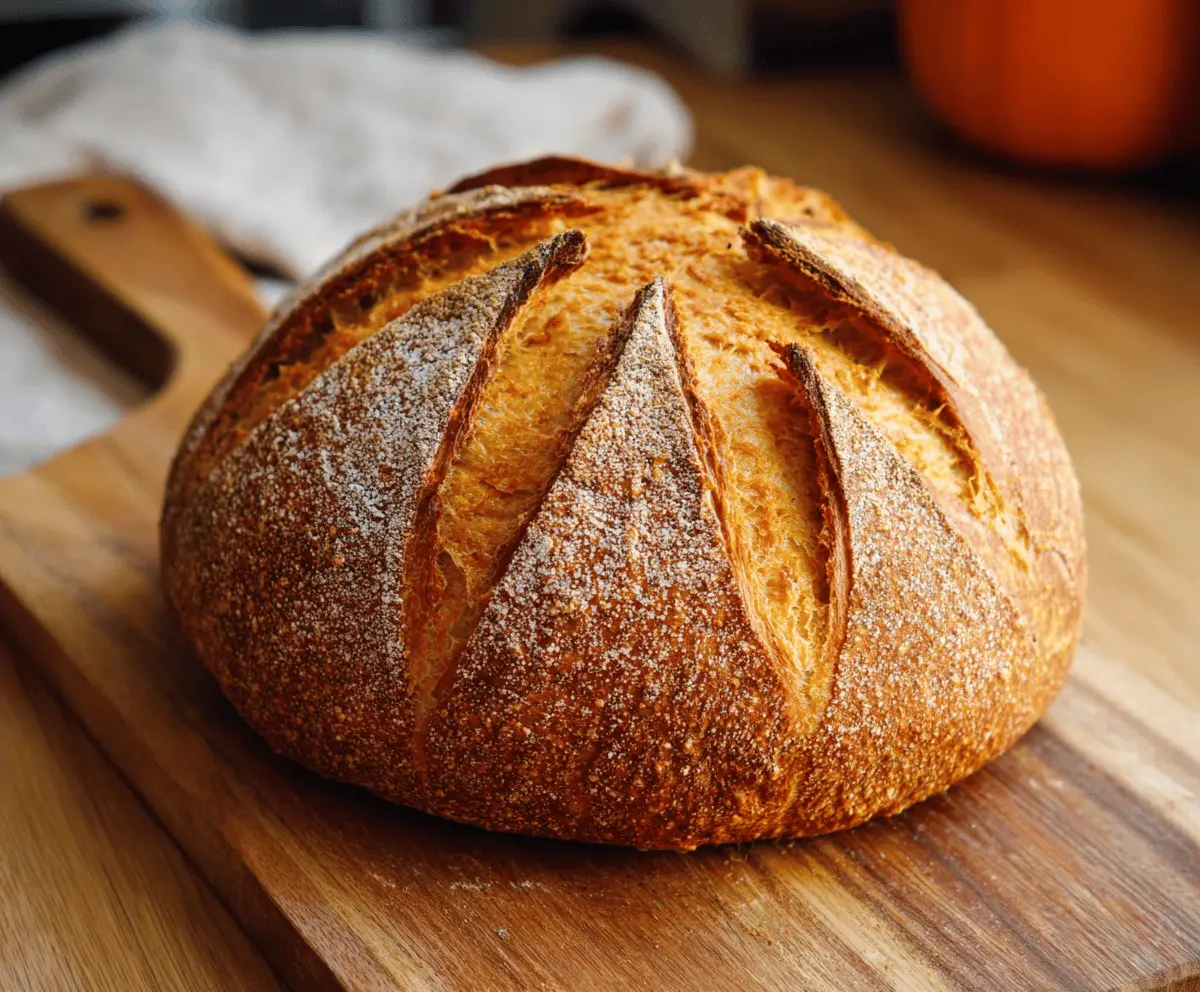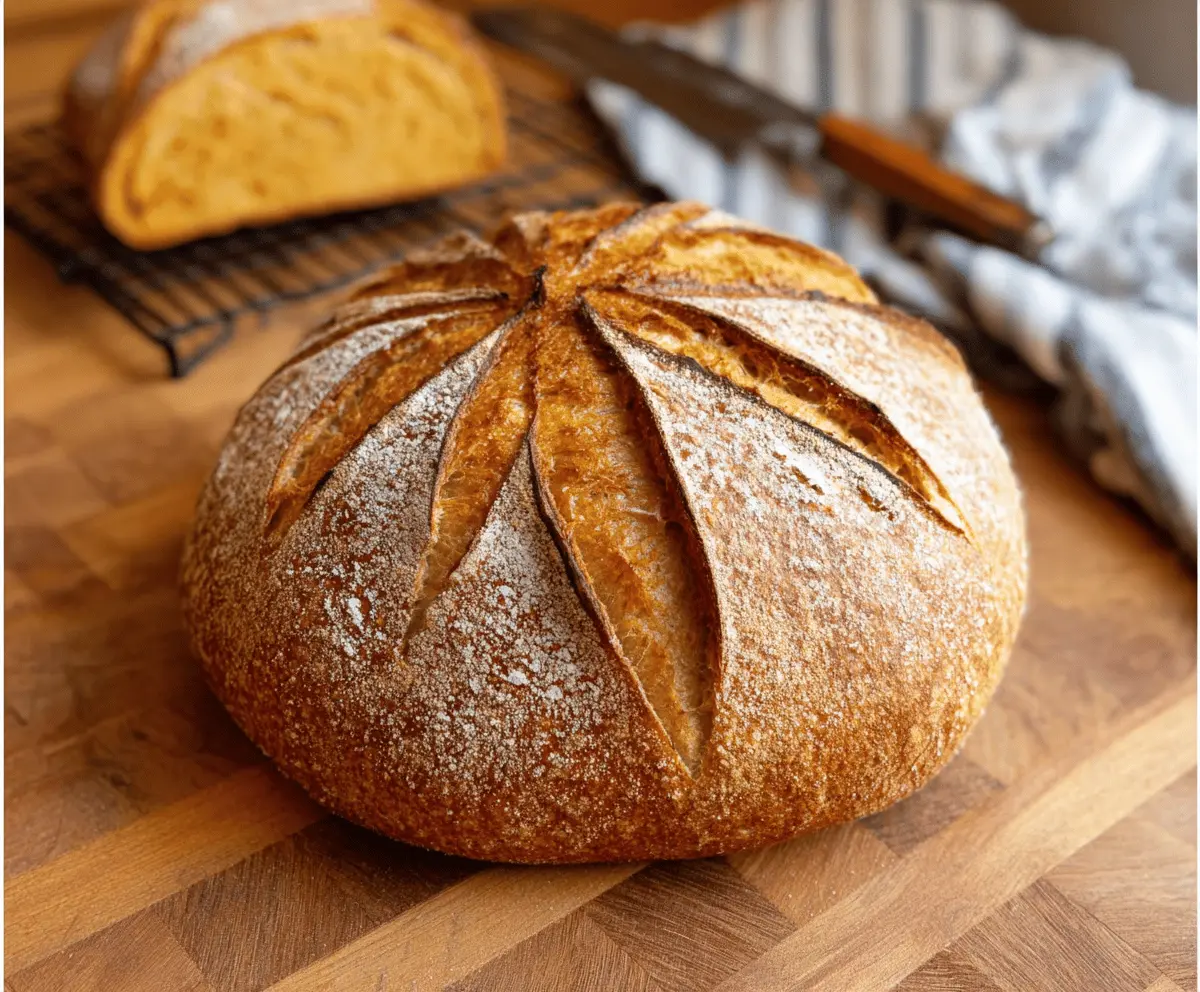This pumpkin sourdough bread has a lovely orange hue and a warm, spicy smell. It’s soft inside with a nice crust outside, perfect for any fall day!
I love to enjoy it with a spread of butter or cream cheese. It’s so tasty, you might find yourself eating it for breakfast, lunch, and dinner! 🥰
Key Ingredients & Substitutions
Bread Flour: This gives the bread structure. If you need a substitute, you can mix all-purpose flour with a bit of vital wheat gluten for better results. I find that using high-protein flour really helps create that chewy texture.
Sourdough Starter: Make sure it’s active and bubbly! If you’re out, you can create a simple yeast starter with water and flour in a pinch. But keep in mind, the flavor won’t be quite the same.
Pumpkin Puree: Use either canned or homemade pumpkin puree. Canned is super convenient, but if you roast fresh pumpkin, it adds great flavor. Avoid sweetened varieties as they can throw off the taste.
Spices: The mix of spices adds warmth and depth. For a twist, consider adding a pinch of cardamom or even using pumpkin spice mix. I love to adjust spices based on seasonal tastes!
How Do I Perfectly Shape My Dough?
Shaping might feel tricky, but it’s key for a good rise! Here’s how to do it right:
- After bulk fermentation, turn the dough onto a floured surface gently.
- Use a bench scraper to help with sticking and to cut the dough if needed.
- Stretch the edges of the dough towards the center to form a round shape.
- With both hands, cup the dough up and under to create surface tension when shaping.
- Try not to overwork the dough; you just want it smooth and tight.
This way, when you score it before baking, you’ll get that nice oven spring, and your loaf will look stunning! Plus, it helps lock in the moisture for that tender crumb.

How to Make Pumpkin Sourdough Bread
Ingredients You’ll Need:
For the Bread:
- 500g bread flour (about 4 cups)
- 100g active sourdough starter (fed and bubbly)
- 150g pumpkin puree (canned or homemade, unsweetened)
- 300g water (lukewarm, about 1 1/4 cups)
- 10g salt (about 2 tsp)
- 1 tsp ground cinnamon
- 1/2 tsp ground nutmeg
- 1/4 tsp ground cloves
- 1/4 tsp ground ginger (optional)
- Extra flour for dusting and shaping
How Much Time Will You Need?
This pumpkin sourdough bread requires about 20 minutes for preparation and 3 to 5 hours for bulk fermentation. Additionally, you’ll need to chill it overnight for around 8 to 12 hours, plus another 40-50 minutes for baking. It’s definitely worth the wait for that lovely flavor!
Step-by-Step Instructions:
1. Mixing the Dough:
In a large mixing bowl, combine the bread flour, cinnamon, nutmeg, cloves, and ginger. Give it a good stir to mix the spices throughout the flour. Then, add in the pumpkin puree and lukewarm water. Mix everything together until just combined; don’t worry if it seems a bit sticky at first!
2. Adding Starter and Salt:
Now, add your active sourdough starter and salt to the bowl. Mix it thoroughly, ensuring the starter and salt are well incorporated into your dough. This is where that sourdough flavor really starts to build!
3. Autolyse Phase:
Cover the bowl with a damp cloth or some plastic wrap and let it rest for 30 minutes. This process is called autolyse and helps develop the dough’s structure.
4. Develop Gluten:
After the rest, perform a series of stretch and folds. Do this every 30 minutes for the next 2 hours (about 4 sets). Reach under the dough, stretch it gently upward, and fold it over itself. This will help develop the gluten and create a nice texture.
5. Bulk Fermentation:
Once you’ve finished your stretch and folds, cover the dough again and let it bulk ferment at room temperature for 3 to 5 hours. Keep an eye on it—you’re looking for it to double in size and become airy!
6. Shaping the Dough:
Turn the dough out onto a lightly floured surface. Shape it into a tight round loaf by folding the edges into the center and cupping it underneath to create surface tension. It’s important to be gentle but firm!
7. Prepare for Cold Fermentation:
Place the dough seam-side up in a floured banneton basket or a bowl lined with a floured kitchen towel. Cover it and refrigerate the dough overnight (8-12 hours) for a cold retard fermentation to enhance the flavor and make scoring easier.
8. Preheat the Oven:
On baking day, preheat your oven to 450°F (230°C). Place a Dutch oven inside to heat for at least 30 minutes.
9. Scoring and Baking:
When you’re ready to bake, carefully invert the dough onto parchment paper. Use a sharp blade to score the top, which will allow the bread to expand beautifully while baking. Then, using the parchment paper, lift the dough and place it into the hot Dutch oven, cover with the lid, and bake for 20 minutes.
10. Final Baking Steps:
After 20 minutes, remove the lid and continue baking for an additional 20-25 minutes until the crust turns a deep golden brown. Your kitchen will smell amazing during this process!
11. Cooling:
Once done, carefully transfer the bread to a wire rack to cool completely before slicing. This step is crucial to develop the final texture!
Now, you’re all set to enjoy your delightful pumpkin sourdough bread. The slightly spiced aroma and tender crumb are sure to be a hit. Happy baking!

Can I Use Different Flours for This Recipe?
Absolutely! While bread flour gives the best structure, you can use all-purpose flour. If you want a chewier texture, add some vital wheat gluten. Just keep in mind that the results might be slightly different.
How Do I Store Leftovers?
To store leftovers, wrap the loaf in plastic wrap or place it in an airtight container. It’ll stay fresh at room temperature for about 2-3 days. For longer storage, slice the bread and freeze it in a bag for up to 3 months. Just toast or thaw slices as needed!
Can I Add Mix-Ins to This Bread?
Definitely! You can mix in nuts, seeds, or dried fruit like cranberries or raisins for added texture and flavor. Just be careful not to add too much, as it might affect the dough’s hydration.
Can I Use Fresh Pumpkin Instead of Canned?
Yes, you can! Just roast fresh pumpkin until tender, scoop out the flesh, and puree it until smooth before using. It adds a lovely fresh flavor, but be sure to measure it properly to maintain the right consistency in your dough.


